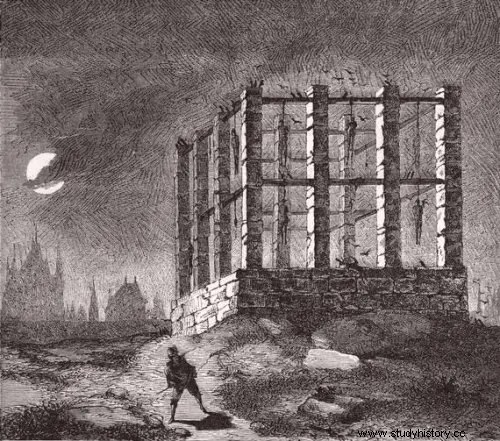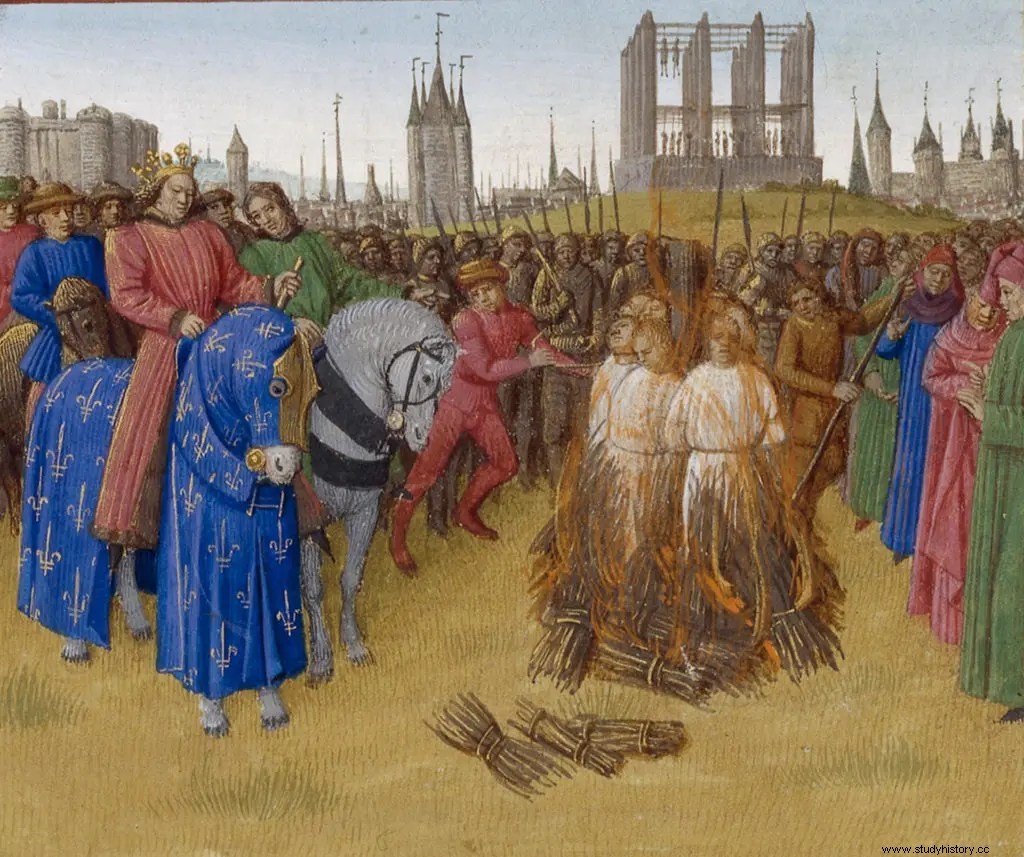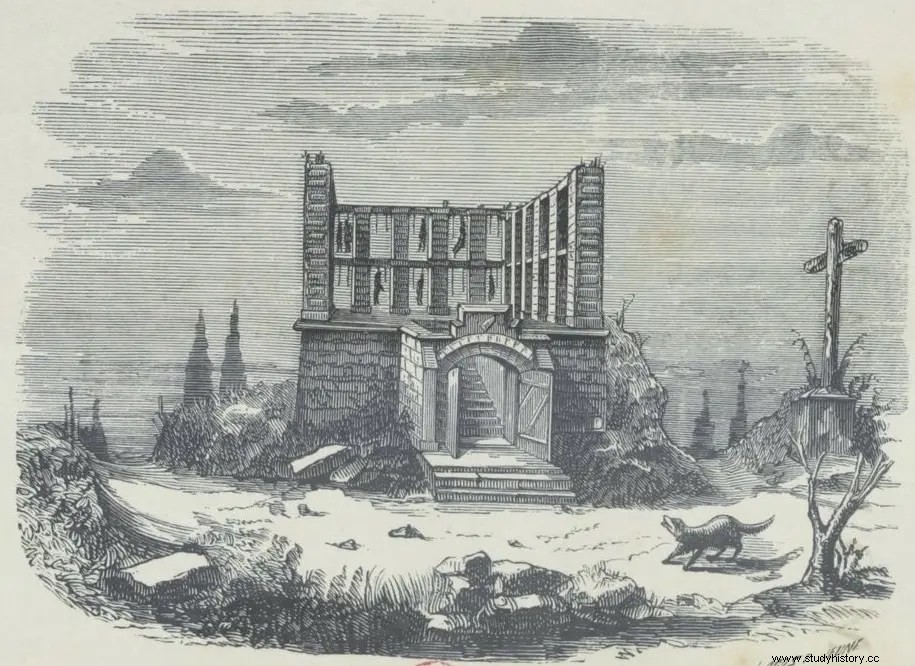It was a horrible profile against the sky, that of this monument; especially at night, when there was a little moonlight on those white skulls, or when the evening wind rustled chains and skeletons, and stirred it all up in the shadows
Victor Hugo – Notre-Dame de Paris
The Montfaucon gibbet, an isolated silhouette on its mound exhaling death, has haunted the imagination since its construction in the 12th century until today, more than three centuries after its total destruction!
From execution to exhibition
In the Middle Ages, Parisian spaces dedicated to executions are legion. Drownings, beheadings, pyres or quartering are practiced on the Pont-Neuf and Saint-Michel, at the Saint-Jacques and Saint-Denis gates, in the courtyards of the Châtelet and the Palais de Justice, on the forecourt of Notre-Dame, in the Porceaux market for heretics, in the pillory of Les Halles, or on the Place de Grève and then on the Place Maubert.
A distinction can be made between the actual place of execution and the site where the corpses are displayed for several days, even several years, until the skeleton decomposes:the Middle Ages loved these macabre exhibitions aimed at discouraging all those who for ambition to commit any misdeed… The constructions dedicated to these sinister spectacles are baptized “sinister forks”. They are generally made up of pillars on top of which the victims are hung. The number of these pillars varies according to the quality of the lords who own them:eight for the dukes, six for the counts, four for the barons, two for the gentleman justices… Yes, putting to death is a privilege! Of course, the king alone can build as many pillars as he wishes. These sinister forks are also used as a place of execution by hanging and then serve as gibbets.
The gibbet of Montfaucon was, for several centuries, the most important royal gibbet where the implacable Justice of Paris was exercised and the place of exhibition of corpses par excellence:up to fifty, even sixty at a time! When it was built around the 12th century, the gibbet was located well outside of Paris, on the land of a certain Count “Falcon” or “Fulco”. It rises on a hill at the end of the Faubourg Saint-Martin, a district which will not be included in the Paris conurbation until the end of the 17th century. Quickly nicknamed "Mont Falcon" then "Montfaucon", the gibbet remains outside the walls erected a little later by Charles V around the capital. Its location today roughly corresponds to that of the Saint-Louis hospital in the 10 e rounding.

A deterrent mass grave
The architecture of the gibbet, first in wood, evolved over the centuries. In the 15th century, it rose nearly fifteen meters above the ground, resting on a stone plinth. Sixteen large square pillars are linked together on two or even three levels by solid wooden beams. The victims are hoisted to the top using ladders to hang them on the beams using iron chains.
The underside of this dismal edifice was occupied by a vast underground passage where they threw the corpses that had been taken down to make room for the new victims, the human shreds that had fallen from the gibbet, and again the bodies of the criminals executed in the city.
Montfaucon, its gibbet, its roads…
This hollow center where lies a heap of human remains turns into a mass grave of choice for the sorcerers who populate the slums of the capital:at nightfall, they steal bones and other organs for their dubious mixtures... Predations that pose a real problem, so much so that in 1407, the Parliament invested the Provost of Paris with a very specific mission, that of "actively prosecuting the individuals who stripped the gibbets of the carrion of those who had been hanged there. » The gibbet is surrounded by an enclosure closed by a large door.
The stench emanating from this pile of corpses sometimes becomes unbearable. When Louise of Savoy, mother of King François I st , died at the Château de Saint-Maur in 1532, the monarch ordered that the gallows placed on the path of the funeral procession be stripped. The corpses and decomposing body parts are moved and buried in cemeteries, ensuring a more... breathable path for the multitude who came to follow the convoy to Notre-Dame de Paris!
Be that as it may, Montfaucon remains the very embodiment of royal justice, which issues a clear warning to travelers passing through before entering Paris:a guaranteed dissuasive effect!
From more than a league around we discovered this sinister colonnade, this temple of death, which, isolated and dominating part of the city and the surrounding countryside, was the oldest and most superb gallows in the kingdom.
Montfaucon, its gallows, its roads…
The waltz of the condemned
Convicts executed on the very site of Montfaucon are transported on horseback, in carts and sometimes on foot from the capital, their hands tied. A salutary break was granted to them at the convent of the Filles-Dieu, at the current location of the passage du Caire rue Saint-Denis. The prisoners are then offered their last meal:three pieces of blessed bread and a glass of wine. If the victuals are gulped down with relish, it is considered a good omen for the salvation of their souls! The procession then resumes its march to Montfaucon. As for the corpses of the condemned executed in Paris, they are transported to the gallows piled up in carts.
The exhibition of naked corpses is completely unthinkable. The executioners therefore have the delicacy to wrap their victims in canvas or leather bags before hanging them by the armpits. Vision of horror that these tens of emaciated corpses, swayed by the wind in their clothes of misfortune, in the squeak of the iron chains...
This ritual deprives the condemned of the privilege of resting in the holy land, and dishonors them by the public display of their remains.
The body of the condemned man and the urban fabric

Famous personalities are hanged in Montfaucon:Enguerrand de Marigny, Grand Chamberlain and Prime Minister of Philippe le Bel, accused of having plundered the finances, in 1315; Girard Gueste, finance minister of Philippe le Long, accused by his successor, Charles le Bel, of embezzlement of money, dies under torture before being dragged through the streets of Paris and then suspended in Montfaucon; In 1328, Charles le Bel still had his main treasurer Pierre Remi hanged. Then Philip VI inflicted the same fate in 1331 on Macé de Marches, in charge of the royal treasury, and in 1333 on René de Siran, master of coins.
In 1409, the body of Jean de Montaigu, Grand Master of France under Charles VI, was hung on the gallows, accused of witchcraft and poisoning but above all jealous for his prodigious fortune…; in 1481, Olivier-le-Dain, Count of Meulan, intimate adviser to Louis XI, nicknamed the Devil by the population who hated him, was attached to the gibbet for a few days; Jacques de Beaune Semblançay, superintendent of finances to François I was hanged in 1527; the headless body of the famous Admiral de Coligny, leader of the Protestants savagely murdered by the Catholics during Saint-Barthélemy in 1572, remained for a long time hanging from the gallows by the feet before his cousin François de Montmorency stole his remains!
The list of lords, petty bourgeois and lowly thieves whose corpses are thus offered as a spectacle in Montfaucon is endless. Miscarriages of justice and gratuitous executions are countless!
Didn't it seem that around its ruins the shadows of a crowd of innocent people wandered, coming to demand a belated and sterile rehabilitation from the place where they had paid with their heads for the high favor to which fortune had raised them? ?
Old sinister forks of Montfaucon
The exquisite particularity of the Montfaucon gallows is that it is used for another type of torture that is rarer but very popular:the living burial of women. Traces remain of these tortures:a woman named Marion de La Court, taken to Montfaucon on January 20, 1392, confirms before the open grave her past confessions and adds a list of impressive thefts so as to "discharge her soul more serenely and and repentance of her sins" before being buried alive. In the 15th century, Jeannette la Bonne Valette, Marion Bonnecoste, Ermine Valancienne and Louise Chaussier were buried in the pit dug below the gibbet as punishment for their “demerits”. In 1460, a certain Perrette Mauger, "a thief and concealer by profession" had to "suffer dead and be buried alive in front of the gallows":she tried to escape this torture on the pretext of pregnancy, but the diagnosis was invalidated and she was immediately brought to the pit…

From Montfaucon to the Buttes-Chaumont
In the middle of the 17th century, the badly maintained gibbet of Montfaucon practically ceased to be used. All the same, from time to time, we insist on hanging a few corpses from two or three worm-eaten beams which miraculously still stand upright. However, it was not until 1760 that the gibbet was completely destroyed.
From the middle of the 17th century, the site of Montfaucon, further south of the site where the gallows stood, became a place of deposit of the rubbish of Paris, in a century when the filth of Paris was frightening and where the ublic hygiene becomes a problem that the royal power tries to solve by sending outside the capital the waste which does not cease increasing. The place was then transformed into a rendering center, always with a view to limiting the risks of disease and contagion resulting from the exponential growth of butcher shops in Paris.
An ordinance of 1849 abolishes Montfaucon to develop very pleasant public gardens on this cursed land:mandated by Napoleon III, Baron Haussmann thus had the Buttes-Chaumont gardens built, today a renowned space in Parisian life!
